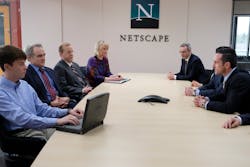National Geographic’s new miniseries, Valley of the Boom, is going to be available on Sunday, January 13th. It covers a number of real-world companies that were around at the start of the internet before the dotcom bust, including Netscape (see figure), Pixelon, and The Globe. Netscape Navigator was the cutting edge for internet browsers, but Netscape and Microsoft did not see eye to eye. Pixelon was into streaming video before we knew what that was, although trying to make things work with telephone modems was a compression chore that verged on the impossible. Details like that didn’t stop founder “Michael Fenne,” however, at least initially. The Globe didn’t turn into Facebook and Twitter, but not for the lack of trying.
National Geographic’s new miniseries, Valley of the Boom, includes a number of stories, including Netscape and Pixelon.
I can definitely recommend Valley of the Boom having lived through the era and seen an early viewing of the miniseries. It has an interesting way of presenting the facts and fiction. The hybrid presentation is informative, if a little on the light side. It includes narratives by Mark Cuban and Arianna Huffington. The six episodes highlight Silicon Valley in the 90s.
I suspect that the juxtaposition of the release of Valley of the Boom and Microsoft’s recent announcement is that its next browser will be based on Google’s open-source Chromium Project. That’s a long and twisted way from the battle between Netscape and Microsoft highlighted in the miniseries. Back then, Netscape was riding high and Microsoft was panicking as the internet went from a dream to the fundamental communication medium. Netscape pioneered many technologies like Javascript and SSL.
The Quick-Changing Landscape
Microsoft essentially drove Netscape into the ground while getting caught up and losing an antitrust case that ended in a consent decree in 2002. Microsoft tied its Internet Explorer (IE) to the innards of the ubiquitous Microsoft Windows, leading to numerous hacks that then had access to the innards of the operating system.
Microsoft has flourished while Netscape got acquired by America Online (AOL), which in turn got picked up by Time Warner. Time Warner then was gobbled up by AT&T. AOL was spun off and is now owned by Verizon.
But back to IE.
IE did get a good bit of competition, especially from free and open-source projects like Firefox. But even as browsers proliferated, so did the headaches for web designers. Compatibility has been the bane of browsers as each tried to push the envelope with new features or incompatible extensions. HTML 5 and CSS have helped a lot, but continued incompatibility is why I have half a dozen browsers on most of my computers and smartphone.
IE eventually fell behind, so Microsoft foisted its new Edge browser on Windows 10 users. IE was still in the wings for backwards compatibility, and to allow users to do things like online banking, since Edge was a bit new for most websites still trying to support different browsers. Luckily Edge does not have the intimacy that IE has with the operating system.
The rising star of late is Google’s Chrome. It’s based on the open source Chromium Project. IE used to be the gold standard for website support. Chrome has replaced it. Likewise, Chrome has garnered a following of third-party plug-ins that used to be the reason for using browsers like Firefox.
Having two major browsers based on a common platform will be a help for web designers assuming no major divergence from code coming from the Chromium Project.
Of course, there’s a flip side to having a common code base: viruses and associated hacks through the browser. My, what a big user base you have. The better to hack you with my dear.
Things have changed since the 90s and it was not that long ago. Now we can use the internet to watch Valley of the Boom on your smartphone, smartwatch, or virtual-reality glasses.
P.S. You can check out my Rising Star Industries encounter with Valdocs that even predates the Valley of the Doom timeframe on YouTube. Look for the mailman.
About the Author
William G. Wong
Senior Content Director - Electronic Design and Microwaves & RF
I am Editor of Electronic Design focusing on embedded, software, and systems. As Senior Content Director, I also manage Microwaves & RF and I work with a great team of editors to provide engineers, programmers, developers and technical managers with interesting and useful articles and videos on a regular basis. Check out our free newsletters to see the latest content.
You can send press releases for new products for possible coverage on the website. I am also interested in receiving contributed articles for publishing on our website. Use our template and send to me along with a signed release form.
Check out my blog, AltEmbedded on Electronic Design, as well as his latest articles on this site that are listed below.
You can visit my social media via these links:
- AltEmbedded on Electronic Design
- Bill Wong on Facebook
- @AltEmbedded on Twitter
- Bill Wong on LinkedIn
I earned a Bachelor of Electrical Engineering at the Georgia Institute of Technology and a Masters in Computer Science from Rutgers University. I still do a bit of programming using everything from C and C++ to Rust and Ada/SPARK. I do a bit of PHP programming for Drupal websites. I have posted a few Drupal modules.
I still get a hand on software and electronic hardware. Some of this can be found on our Kit Close-Up video series. You can also see me on many of our TechXchange Talk videos. I am interested in a range of projects from robotics to artificial intelligence.



